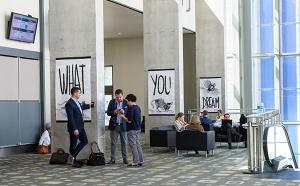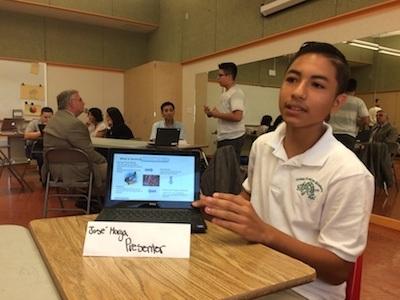Impossible Foods Building the Next Bloody, But Meatless, Burger


If plant-based protein becomes the norm -- and meat production becomes only a minor, not major, contributor to the world’s problems coming from carbon emissions and pollution -- then much of the credit should go to Stanford University researcher Patrick Brown. The professor of biochemistry, who has spent much of his career on genetic research, has taken on a new quest: finding alternatives to animal farming. And one of his ideas is a plant-based hamburger that oozes out blood like the real thing.
His brainchild is Impossible Foods, a Redwood City, California startup that has scored $75 million in venture capital funding, according to the Wall Street Journal. The company is developing fake cheeses and meats, including his beef substitute that uses plant-based molecules to recreate a more environmentally friendly, and humane, alternative to steak and hamburger. In his quest to change how we eat, and put a dent in the global meat industry, he is focusing on the environmental argument while trying to develop a product that has the taste and texture of the real thing — eschewing the emotional and ethical arguments typical of the anti-meat crowd.
Other companies are on a similar mission, such as Beyond Meat, the Southern California-based firm that has been supplying Whole Foods and other retailers with chicken strips that taste practically — I would argue better — than the real thing. Beyond Meat uses a mixture of carrot fiber, amaranth and pea flour for a product that can be mixed with pasta or grilled like fajitas. Like Impossible Foods, these companies are on a mission to develop products that are cost-competitive, and eventually cheaper, than meat from cows or chickens. If they and other companies succeed, they can help fight the global obesity epidemic, help stall global emissions, put a salve on what many see as a cruel industry, and free up land otherwise used for pasture and other livestock farming.
And these companies have got to succeed if we are going to come close to making a dent in our addiction to meat. Let's address a few of the social and economic realities. Many of the meat alternatives out there are of poor quality, and made from a base of gritty soy or manky fungus — not to mention that they are often hyper-processed. While diets can and will change, they do slowly — so shaming people to switch meats for seitan, lentils or mung beans will not work. Many people have grown up accustomed to the taste and texture of meat, or are developing a liking for it abroad as the global middle class expands. So we can talk until we are blue in the face (or blue like some meat in China) about animal cruelty, the fact the meat industry is a larger carbon emitter than the transport industry worldwide, that more land is used to raise food for animals than humans, and the health risks of consuming too much animal fat and protein. A good quality product, at a fair price, however, will get some attention.
It will be interesting to see if Impossible Foods can succeed. The quest to find new environmentally-friendly protein is analogous to developments in safe, renewable energy — many ideas work in the laboratory, but cannot scale. Another question is whether consumers will salivate, and not be creeped out, by a fake hamburger gooey with fake blood. But Dr. Brown and his Redwood City crew are not developing new products for vegans, but for the mass market. And if they become Facebook-IPO rich while we scale back global meat production, power to them.
Image credit: Impossible Foods
After a year in the Middle East and Latin America, Leon Kaye is based in California again. Follow him on Instagram and Twitter. Other thoughts of his are on his site, greengopost.com.
7 Strategies for Achieving LEED Certification


Want to learn more about integrating LEED into a sustainability report? We're bringing our GRI certified sustainability reporting course to Las Vegas and including a special section on LEED. This course is hosted by ARIA- MGM Resorts International and will be complemented with information on LEED requirements, Energy Efficiency, and a tour of the Aria's efficiency measures! For more info or to sign up, click here.
Leadership in Energy and Efficient Design (LEED), the certification standard set by the U.S. Green Building Council, is transforming how many buildings are constructed, remodeled, maintained and operated. The program utilizes numerous categories: sustainable site, water efficiency, energy and atmosphere, indoor environmental quality, and materials and resources. Is the building close to public transportation? Does it use locally-sourced building materials? These are all important questions when seeking LEED certification.
Achieving LEED certification is a powerful tool for for companies undertaking Global Reporting Initiative (GRI) sustainability reporting, which measures an organization's economic, social and environmental impacts and communicates them to a diverse group of stakeholders. GRI reports identify ways to improve in these three areas, and the built environment significantly impacts all three. So, pursuing LEED certification can be an avenue for achieving goals established from GRI reporting.
Indoor environmental quality, for example, impacts employee well being by providing high indoor air quality and ample natural daylighting. This can boost the bottom line by improving productivity, reducing absenteeism and lowering operating costs. If higher indoor air quality is achieved through the use of nontoxic finishes and less electricity is used to light the facility, then this also reduces the environmental impact of the facility.
With these things in mind, use these seven strategies if you want to achieve LEED certification and meet your GRI goals.
1. Set LEED-certification targets that correlate with GRI goals
There are four levels of LEED certification: certified (40-49 points), silver (50 to 59 points), gold (60 to 79 points) and platinum (80+ points). The desired certification level and associated credits may correlate with goals resulting from GRI reporting.
For example, if your organization wishes to boost energy efficiency, then you may want to maximize passive solar gains, use zoned HVAC controls for different areas of the building, and install daylight-responsive controls. This is an opportunity to optimize your organization's built environment as it relates to social, environmental and financial performance.
2. Use lifecycle value engineering
When designing the project, determine expenses over the lifecycle of the building and how they impact building performance. Lifecycle value engineering, instead of initial-cost value engineering, takes a longer view on features that may have a higher upfront cost -- but will rapidly pay for themselves. Some money-saving features may reduce energy or water use enough to pay for themselves in reduced operating costs within a matter of months, despite a greater upfront cost. This perspective also better enables the team to align with GRI tracking and the triple bottom line.
3. Ensure the project team is on board with goals
If all members of your team aren't working collectively toward common goals, it will be much more difficult to achieve the desired result. Share LEED and GRI goals and outcomes with everyone on the team, including architects, engineers, developers, subcontractors, project managers, landscape designers, etc., and be open to their ideas and feedback.
4. Set high goals to spur creativity
Some organizations set a higher stretch goal for the level of LEED certification in the planning phase to stimulate creativity and out-of-the-box thinking. This is especially helpful during early brainstorming sessions. If it turns out that some ideas are cost prohibitive or don't pass a cost/benefit analysis, plans can be tapered back.
5. Take a collaborative approach
"The earlier you think about building green, the less it costs," says Rob Smith, president of e2 Homes. "To pursue LEED certification, the first thing we did was have a design charrette. It all starts with a brainstorming session to find better ways of doing things that will save money and improve efficiency. Let’s build better and let’s build smarter."
A design charrette is a great opportunity to bring various stakeholders together, including colleagues working on GRI goals and tracking, to ensure a seamless integration of this project with larger organizational goals impacting the triple bottom line.
6. Set an adequate budget
Higher levels of LEED certification typically involve higher expenditures, although some of these green features will pay off over time with lower operating expenses. Establish a realistic budget that can cover your project, along with some unexpected expenses. This ensures that you won't have to cut corners at the end in undesirable ways.
7. Hire LEED-accredited professionals
The USGBC has a process to determine a level of knowledge and familiarity with the LEED-certification process and demonstrated knowledge in green building principles and practices. Having LEED-accredited professionals (LEED APs) on your team will help streamline the design and LEED certification process, particularly if there is significant past experience.
Image credit: Flickr/U.S. Army Corps of Engineers Europe District
New Clorox App Allows Consumers to See More Ingredients Inside


Buying cleaning products has long been a murky process. Few laws requiring companies to disclose the chemicals are on the books — so of course, most companies do not list what they put into those bottles. But for some public health advocates, required ingredients disclosure has been their rallying cry. Now more companies are responding in kind. For example, Clorox recently announced an expansion of its “Ingredients Inside” program and an updated release of its smartphone app that aims to educate customers about the company’s portfolio of cleaning products, from bleach to room fresheners. Fragrances, those pesky additives where it is almost impossible to sort out how they are formulated, are the latest addition.
And indeed, that is quite a laundry list of fragrances Clorox uses in all of its products. But that list is it — no other additional information about these ingredients was released. Consumers who want more information are directed to a Wikipedia page, or the International Fragrance Association. One can also download a list in PDF format if they want to learn the industry names of the fragrances. So, are these updated apps and disclosures actually helpful to consumers, or is this just marketing in the guise of transparency?
It is true that Clorox is doing more to reveal its ingredients than other cleaning products companies. And fair enough, as far as we know, there has been no massive class-action lawsuit resulting from the nefarious use of fragrances. Most companies test their products rigorously (we would hope) to avoid any costly litigation or branding image headaches. But for the average consumer like me (who barely remembers high school- or college-level chemistry), a list of ingredients on an app does not really tell me much. For example, I am told that the sodium lauryl sulfate (SLS) in one of Clorox’s “green” products is “commonly used in household cleaners, detergents and soaps because of its soil removing and foaming abilities.” Okay, so a Wikipedia CliffsNotes description. So, is this ingredient really safe? Are there any health or environmental impacts? And where does SLS come from? How is it manufactured?
It is up to the consumer to do more research if he or she wants more information on ingredients. For example, to learn more about the potential health or environmental risks of sodium lauryl sulfate, I pulled up an article on Mercola.com. The article seemed balanced enough: It dismissed some rumors and untruths about SLS, talked about studies discussing potential health and environmental issues, and gave a decent overview about this ingredient that is in countless consumer packaged goods.
So, while Clorox is ahead of the game when it comes to ingredients disclosure, overall the industry still has a lot of work to do when it comes to ingredients transparency. Here’s a challenge I would like to see these companies take on: Allow customers to link to articles about these ingredients — one from a credible industry association, and one from a credible health or consumer safety NGO. Let the consumer read both sides and make an educated choice if that ingredient is one he or she trusts. And of course, there is a place to disclose these mysterious ingredients: on the product label.
Of course, if all this is too much of a headache, there is one simple solution that is also safe and saves money: Fill a spray bottle with a 5 percent white vinegar solution and a few drops of extract or essential oils, then spray and scrub away.
Image credit: Ingredients Inside App
After a year in the Middle East and Latin America, Leon Kaye is based in California again. Follow him on Instagram and Twitter. Other thoughts of his are on his site, greengopost.com.
We Can Absolutely Stop the Spread of Ebola


By Robin Kim
While Thomas Duncan was dying from Ebola in Dallas, Texas, two brothers, Ali, 6, and Satique, 9, were recovering. They are leaving their treatment center in Sierra Leone to return home to their dad.
Tales of survival are rare moments of triumph in an epidemic whose power to terrify is having deadly consequences on economies and societies. Yet these bright spots also deserve to be known because they can lead to more bright spots, greater impact -- and hope transformed into truth.
Other bright spots include UNICEF, which is using its global presence, knowledge, relationships and infrastructure to identify, develop and propagate the best ways to contain and treat Ebola. Its door-to-door prevention campaign will reach every household with life-saving information and protection kits.
These bright moments include that of Dr. Paul Farmer: His organization, Partners in Health, provides community-based care for millions in the developing world, and his efforts to curb Ebola in Liberia are yielding success. “There is no need for the majority of people with Ebola to die if they're diagnosed quickly and receive effective and prompt supportive care,” he told an audience in San Francisco last week. “The best way to stop Ebola is to wipe it out at the source, where the epidemic is currently out of control.”
They include Nigerian Finance Minister Ngozi Okonjo-Iweala’s opinion editorial in Wednesday’s Financial Times, showing how decisive leadership, with the right resources and a highly coordinated response, are resulting in a halt of the disease in the country since its first incident on July 20, with 12 survivors from Nigeria’s 20 victims.
They include Microsoft co-founder Paul Allen's foundation, which has partnered with UNICEF and UPS to deliver more protection aid via a $3.6 million matching gift fund, enabling more successes to be possible.
And within the Bay Area, one year ago the U.S. Fund for UNICEF opened its eighth regional office in San Francisco – another bright moment. The timing could not have been better. I joined their Board along with seven others.
It is absolutely possible to stop the spread of Ebola -- if we act quickly. And it is also fully in our power to create more bright spots. My donation to UNICEF to stop Ebola, for example, will be matched dollar-for-dollar by the Paul G. Allen Family Foundation. Yours will too. It doesn’t have to be a big donation. It can be $1, or $10. It doesn’t matter how much. It simply matters that we do something. Give something.
Here’s the link to donate. Let’s do it.
Image credit: UNICEF/NYHQ2014-1522/La Rose
Robin Kim is a member of the Northwest Board for the U.S. Fund for UNICEF
Experts Discuss Tackling Big Problems Through Design at SXSW Eco


This post is part of Triple Pundit's ongoing coverage of the SXSW Eco conference. For the rest, please visit our SXSW Eco page here.
On the first day of SXSW Eco, design experts discussed examples of how creative design makes sustainability easy, cost-effective and beautiful. Moderated by Vince Digneo, sustainability strategist for Adobe Systems, panelists from Frog Design, Building Robotics and Levi Strauss & Co. showcased their innovative approaches to solving problems while making their products, services and consumer experiences better.
Denise Gershbein explained Frog Design’s position: They help their customers with global production design that is long-term and systems focused. She explains that cradle-to-cradle and visionary thinking is at the root of their design consultations, and these are the most important attributes that lead the non-linear design process towards solving complex sustainability problems.
In my view, the most interesting component of the panel was Paul Dillinger’s deep dive into the sustainability-driven design tactics he leads at Levi Strauss. He began with the recognition that the fashion industry has a notoriously bad reputation for being highly wasteful and unsustainable, from the mostly unrecyclable materials through the environment-intense chemicals. This is a result of an industry that is primarily concerned with trend relevancy and valuing consumer needs over the bigger picture of eco-consciousness. There is a trend in 'eco-fashion' labels, but he notes that the design and marketing approaches they utilize often only address one issue of a very large and complex system, like focusing solely on the use of organic cotton.
He attributed this shortcoming in the fashion industry to the consideration of environmental constraints as barriers to creativity and freedom of design. But in fact, Dillinger, the company's head of global production innovation, said he uses these as springboards for innovation and sustainability. He feels that the process of unlocking environmental and social qualities that can be built into pieces of clothing is actually more creatively rewarding, and he has seen firsthand how these attributes can create more business and consumer benefits.
Traditionally, a pair of jeans uses 4,000+ liters of water throughout its lifecycle. In the production phase, a large portion of this water usage comes from the dying process, which is comprised of about 18 dye-dipping cycles. To cut back, Dillinger shared that his company has developed a nearly waterless method for dying denim that instead utilizes pressure, which has resulted in 50 to 75 percent water savings. Outside of production, 45 percent of the water usage for a pair of jeans happens after they leave the store and are in the consumer’s hands. Most companies are not necessarily invested in what happens outside the realm of their factories. However, Levi’s has addressed this issue as well, by instructing consumers to wash with cold water and to line-dry their jeans and shirts.
He then posed a question to the room: Have any of you tried to dry a shirt on a hanger with satisfaction? The reality is: Wire hangers leave those undesirable stretch marks on the shoulders. To make their customers’ experience better, Levi's reinforces that area on their shirts so they can better withstand air-drying. This clever design trick not only saves energy and water, but is also a great example of how creative design can be more sustainable and consumer-friendly. The two do not need to be mutually exclusive.
In addition to water use, Dillinger gave yet another example of how inserting sustainability values at every step of the creative design and production process can have outstanding benefits: He explained that most clothes are unrecyclable because of the use of polyester thread and tags. Polyester is more durable and can withstand the use of additional dying and finishing chemicals, like the ones used to give jeans vintage looks. He knew the company wanted to shift to cotton, but that would then require a new method of finishing. Through creative experimentation, the company was able to start using a finishing method that utilizes light and lasers. This example stresses the need to think in a systematic and holistic way to solve problems relating to the sustainability of their brand and products.
By purposively inserting environmental and sustainability values into their product design, Levis Strauss & Co. is able to make clothes that are identical to what they have produced in the past -- but now with more inherent values that give them a competitive edge. By factoring in additional social considerations, like adopting fair labor policies and reinvesting in the communities where its factories are located, the company is now better apt than ever to control the unintended consequences and externalities of its business.
Image credit: Rebecca Hedges Lyon (courtesy of SXSW Eco)
8 Companies Working to Eliminate Hunger


With a busy week behind you and the weekend within reach, there’s no shame in taking things a bit easy on Friday afternoon. With this in mind, every Friday TriplePundit will give you a fun, easy read on a topic you care about. So, take a break from those endless email threads, and spend five minutes catching up on the latest trends in sustainability and business.
Thursday, Oct. 16, is World Food Day -- an annual day of action against hunger. Commemorating the creation of the Food and Agriculture Organization of the United Nations on Oct. 16, 1945 in Quebec, Canada, WFD asks people to come together in their commitment to eradicate hunger in their lifetimes.
An estimated 805 million people, one in nine worldwide, live with chronic hunger -- a startling statistic that underscores the importance of action on the issue. While spreading awareness on World Food Day is great, it takes year-round action to secure real change. With that in mind, this week we're tipping our hats to eight companies that are working to eliminate hunger worldwide.
1. Panera Bread
Popular bakery-cafe chain Panera Bread has put a focus on hunger relief from the start. At the end of each day, all Panera Bread locations donate unsold bread and baked goods to local hunger relief agencies. You've likely noticed its Panera Cares Community Breadbox at your neighborhood branch, where the company collects donations from patrons and distributes the funds to local nonprofits in partnership with Feeding America.
The chain is also famous for its Panera Cares Community Cafes, nonprofit locations that provide hot meals to anyone -- whether they can afford to pay or not. The cafes – operated by the Panera Bread Foundation, a separate nonprofit entity – are "meant to raise the level of awareness about food insecurity in this country, while also being a catalyst for change in our communities," the company said.
2. Darden Restaurants
Darden Restaurants, the Fortune 500 restaurant giant known for brands like Olive Garden, LongHorn Steakhouse and Bahama Breeze, began its Darden Harvest program in 2003 to rescue food from landfills and get it to those in need. With full participation from all Darden restaurants, the program has donated more than 77 million pounds of surplus food – totaling more than 100 million meals – to hungry families since its inception.The program also allows the company to divert 11 million pounds of food -- which may have passed internal sell-by dates but is still wholesome and perfectly fit for human consumption -- from landfills each year, a key component to achieving the company's goal to one day send zero waste to landfills.
3. Kellogg
Kellogg has been working to fight hunger for more than 30 years. As part of its Breakfasts for Better Days initiative, the company will donate 1 billion servings of cereal and snacks in support of global hunger relief by the end of 2016. The company donates, on average, more than $20 million worth of food products for hunger and disaster relief each year, in partnership with food bank networks across the globe.In the U.S., Kellogg partners with hunger relief agencies, primarily Feeding America, to donate its products to those who need it most. Through the Feeding America partnership, Kellogg has donated more than 200 million pounds of food in the past decade alone -- and has helped provide more than 221 million meals through food and fund donation since 1983.
4. Yum! Brands
Yum! Brands, the world’s largest restaurant company famous for chains like Pizza Hut, Taco Bell and KFC, created its World Hunger Relief program eight years ago. A personal passion for CEO David Novak, the program aims to feed hungry people while raising awareness, volunteerism and funds for the United Nations World Food Program, which receives 100 percent of donations.The program has raised more than $185 million in cash and food donations and provided nearly 750 million nutritious meals for hungry families. The effort spans 130 countries and leverages 40,000 KFC, Pizza Hut and Taco Bell restaurants and 1.5 million employees around the world, the company said.
5. General Mills
General Mills has partnered with Feeding America for more than 30 years. Through the partnership, the company not only funds critical hunger relief programs, but also provides significant food donations and engages employee and retiree volunteers. In partnership with Feeding America, the company has also created campaigns like Outnumber Hunger to support local food banks and generate action across the network.6. Morgan Stanley
This year, Morgan Stanley launched Healthy Cities, a program designed to coordinate the wellness, nutrition and play resources that give children a healthy start in life. Collaborating with national and local nonprofits, Healthy Cities "helps connect otherwise separate programs and creates a linked package of wellness education and screenings, nutritious foods, and safe play spaces for children in neighborhoods in need," Feeding America said.
Together with Feeding America, Morgan Stanley’s efforts will provide more than 10 million meals and 50 million servings of fresh produce for children. Morgan Stanley employees play a critical role in the partnership, Feeding America says, by delivering strategic planning advice, research assistance, executive counseling and hands-on volunteer engagement nationwide.
7. Cisco
For 11 years, Cisco has matched its employees' volunteer time and donations to address hunger and food insecurity around the world. Its annual Global Hunger Relief Campaign supports more than 160 nonprofits and NGOs to deliver millions of meals.
Last year, Cisco employees worked 44,000 volunteer hours at hunger relief and nutrition nonprofits. With the company tripling all donations made by employees and other donors, the campaign raised $5.7 million for charitable organizations last year -- enough to provide 23 million meals to hungry people around the world.
8. Walmart
In 2010, Walmart and the Walmart Foundation launched Fighting Hunger Together – a $2 billion cash and in-kind commitment through 2015 to fight hunger in America. The company has already reached $260 million in cash and $2.6 billion in in-kind donations, delivering on its commitment one year early.
Through the program, Walmart donated more than 571 million pounds of food – the equivalent of 369 million meals – in 2013 alone. Hunger relief efforts have also been one of the company's most popular employee volunteering platforms, with 4,100 employees volunteering more than 13,000 hours toward hunger relief efforts in 2013.
Of course, there are many more companies that are hard at work on this critical issue. If you know of a company or organization that deserves recognition but isn't included on this list, please tell us about it in the comments section!
Image credit: Panera Bread
Based in Philadelphia, Mary Mazzoni is a senior editor at TriplePundit. She is also a freelance journalist who frequently writes about sustainability, corporate social responsibility and clean tech. Her work has appeared in the Philadelphia Daily News, the Huffington Post, Sustainable Brands, Earth911 and the Daily Meal. You can follow her on Twitter @mary_mazzoni.
Dell, Google Technology Inspires Oakland Middle Schoolers


"Sometimes they just need to bang on something really hard," principal Claire Fisher explains to me when discussing middle schoolers at Urban Promise Academy and the need to maintain the drums in their music program. The middle school keeps energetic students banging away through a variety of grants, fundraisers, and general elbow grease from a pack of community members who are committed to improving Oakland's Fruitvale district.
Fruitvale's BART station gained national notoriety as the location of the fatal police shooting of unarmed passenger Oscar Grant. Urban Promise Academy (UPA, pronounced oo-pah) is a small middle school with a student body that is 87 percent latino or hispanic. Fifty-six percent of the students are English Language Learners, and 90 percent of students qualify for free and reduced lunch. In short, it's a group of students who didn't start out with a lot of advantages. But UPA is not interested in focusing on the past, it is interested in getting these students to "college, career and beyond."
Part of that preparation means making sure that they have an opportunity to engage with the technology that they'll need in the future. There are many sections of Oakland where upwards of 50 percent of the residents don't have computers or internet access at home, so the pressure is on schools to introduce the students to the technology that will help them be successful in life.
UPA has partnered with Dell to put Chromebooks in the classroom. In fact, there are over 10,000 Chromebooks in use throughout the Oakland Unified School District. OUSD selected Chromebooks in part because of their affordability, but also because of the learning flexibility afforded by the Google Drive platform. Each school has their own opportunity to decide how to use the Chromebooks, and UPA's approach utilizes creativity to get every student's needs met and bring the student body as a whole into the digital age.
At an event yesterday keynoted by Van Jones (in support of his #yeswecode initiative), we got to see some of the more innovative projects these teachers and students are turning out with basic Chromebooks and access to the internet.
Ms. Sears, the teacher of the school's STEM (science, technology, engineering and math) program for high-performing students, has an engineering background, but she uses Chromebooks in her classroom to get the students learning how to code. As she puts it "I want my students to have the skills and knowledge to get jobs at the local tech companies when they leave school." Math teacher Mr. Ramirez uses Chromebooks to offer individualized education to each of the 20-30 students in his classes. Some work independently using IXL to meet their foundational math needs if they are behind, some take Khan Academy courses, some work in small groups (with tape recorders) to do common-core problem solving, and Mr. Ramirez works with a small group on performance tasks. These groups rotate so each student gets a chance in every setting.
6th and 7th grade science teachers Ms. Lehman and Ms. Ball teamed up to offer a program whereby the students designed an experiment to be conducted on the International Space Station. Over the course of half a year, the students worked in small teams to research a problem, create a hypothesis and develop an experiment to test it in microgravity, using the Chromebooks. The computers allowed the students to work on the same document in real time and allowed the teachers to offer questions and comments in the body of the text as the sections of the problem statement came together. Scientists from U.C. Berkeley and NASA volunteered to review and critique the experiments, creating a truly scientifically rigorous assignment. One of the student groups' projects -- on the efficacy of worms at composting in microgravity -- actually won the competition to have their experiment carried out on the International Space Station -- the first time an Oakland public school has been accepted.
With the funding constraints facing public schools these days, it's great to see one example of a school doing a lot with a little, and engaging, inspiring and preparing students along the way.
What is All the 'Collectively' Fuss About?


This week, Collectively.org launched. Described in a press release as a “super brand coalition” platform to “raise awareness and inspire millennials to adopt a more sustainable way of living,” I first thought it was a joke. I rolled my eyes as the email also included a pallid quote from Barack Obama and forwarded it onto the editors here at Triple Pundit with a snicker (which is why, PR people, get to the point right away).
Yes, the “super brand coalition” threw me off, as I envisioned a posse of luxury brands going into the Middle Eastern desert to root out terrorism. But when I scrolled down that same email yesterday, it turns out this is partnership between Forum of the Future and some of the world’s biggest and iconic companies: Marks & Spencer, Unilever, Google, Nike, BT and others are sponsoring this new site while VIRTUE, a division of edgy VICE Media, is curating the site.
And according to sustainability writers out there, that background poses a huge problem for Collectively, and the knives are out. “A slew of major corporations,” and “backed by corporate sponsors,” are among the complaints being lobbed at this new site—as if somehow corporate involvement is a bad thing. The “feel good” stories on Collectively are mocked, and the site is even chided for not covering other stories such as the Aral Sea’s disappearance (shame on us at Triple Pundit, as admittedly we barely covered the disappearance of the world’s fourth largest freshwater lake).
But is the criticism fair, with Collectively not even up and running for a week?
To Collectively’s credit, the 25 or so sponsors are disclosed clearly, with all those atrocious logos that make many a sustainability writer apoplectic. This is no Koch Brothers initiative with a title such as “Responsible Citizens for Sustainability” that is anything but friendly to this movement in which many of us passionately believe. Sure, on a personal note, I am hardly a fan of McDonald’s and Nestlé, but I also recognize the ground-breaking work companies such as M&S, Diageo, Unilever and Kingfisher have done. And yes, Facebook is part of this coalition, too—you know, the trillion-dollar social media behemoth we all love to hate, but flock to it because it allows us to broadcast our favorite news from the likes of Grist, Mashable, Inhabitat and yes, from us here at Triple Pundit. Gather 25 of anyone or any organization in a room and it is doubtful you find the crowd completely palatable.
As for attacking Collectively for its feel-good stories, the reality is that if the dystopian view of climate change resonated with the general public across the world, we as a society would have banded together by now to reverse the trend. Fair or not, the way climate change and its dangers are portrayed have not worked. We can blame and attack traditional media all we want, but in the end they are a business. If climate change resonated, it would be a regular topic on conventional media channels. Instead, the mainstream media outlets prefer to focus more Whitney Houston drowning in a bathtub and that royal baby—because that is what most people want to watch. Those of us who wish to keep tabs on topics more important to us scour the internet to find the news we want. And before we become wistful for the pre-Fox and –MSNBC days when we had fair-minded journalism with the likes of Walter Cronkite, remember that his news show was delivered thanks to advertising dollars from the same companies who helped contribute to get us into this mess we are currently in.
The stubborn fact is that more companies are cleaning up their act, which in turn nudges their competitors to do the same, which in turn will make a difference. Sure, after a few months if Collectively reveals itself to be online greenwashing rag, it will fail and its readers will move on. But before slamming this new publication, and knocking the involvement of Jonathon Porritt—who has done far more to advance the cause of sustainability than all the mason jar-nursing hipster bloggers hiding behind their laptops—let’s welcome Collectively to the conversation. We need more participants in this ongoing discussion, not less.
Image credit: Collectively
After a year in the Middle East and Latin America, Leon Kaye is based in California again. Follow him on Instagram and Twitter. Other thoughts of his are on his site, greengopost.com.
New Handbook: 100 Percent Renewable Energy Both Practicable and Affordable


Advances in renewable energy technology, in concert with new triple bottom line-based approaches to government and business, are key enablers of a transition from polluting fossil fuels to locally-appropriate mixes of distributed, renewable energy systems. The renewable energy transition will not only benefit ecosystems and the environment; well designed and executed policies, regulations, public-private partnerships and inclusive, collaborative business models can address societies' most pressing social and economic challenges as well.
Powering societies wholly on renewable energy technologies widely available today is not only possible, it's affordable, according to a policy handbook produced by the World Future Council and E3 Analytics.
Appropriately titled, How to Achieve 100 Percent Renewable Energy, the WFC-E3 policy handbook uses eight case studies organized according to four themes – cities and communities; regions and states; national governments; and island governments – to illustrate how innovative policies are promoting and paving the way to “fully fossil- and nuclear-free” societies.
A policy framework for achieving 100 percent renewable energy
When WFC and E3 write about societies achieving 100 percent renewable energy, they mean “that all energy needed within the electricity, heat and transport sector in the particular region is coming from renewable sources.”
No doubt, many will take issue with the WFC-E3 report's contention that societies can rely entirely on today's renewable solar, wind, ocean, geothermal and bio-derived resources and technologies to meet all their energy needs. In their How to Achieve 100 Percent Renewable Energy handbook, WFC and E3 lay out a framework of policies that organizations at successively larger degrees of geopolitical scope and scale are using today to achieve that goal.
For instance, the handbook authors highlight that there is tremendous potential to make much greater use of renewable resources for heating and cooling, as well as across the transport sector. Locked into reliance on fossil fuels, government policies and strategies underestimate the potential of renewable resources to meet society's heating and cooling needs, “whether via solar hot water, air-heating and cooling systems, heat pumps, electric heat storage, waste heat recovery, or the development of district heating and cooling systems,” they write.
The same is true to an even greater extent across the transportation sector, according to WFC-E3's 100-percent renewable energy policy handbook. “With a few exceptions, most efforts to increase the share of renewable energy have left the transport sector almost untouched, focusing instead on the electricity sector.”
Five key findings
In Achieving 100 Percent Renewable Energy, WFC and E3's research team highlight five key findings that resulted from their analysis of the eight case studies included in the policy handbook:
- 100 percent renewable energy is both financially and economically advantageous, generating a wide range of benefits for both citizens and governments. The benefits range from savings on fossil fuel imports, improved energy and economic security, as well as reduced energy and electricity costs for governments, local residents and businesses.
- The goal of achieving 100 percent renewable energy is not only for wealthy or industrialized countries – it is taking root in countries and jurisdictions in all four corners of the globe, including in Africa, the Asia-Pacific region, as well as Latin America. 100% RE provide a plethora of development benefits that have a high priority among governments across the world. Since almost 3 billion people suffer from both, erratic or no access to electricity and reliance on inefficient and polluting solid biomass fuels for cooking, 100% reliable, affordable and efficiently used renewables are the only realistic, long-term options for ensuring a more decent livelihood for all.
- The report finds that transitioning to 100 percent renewable energy can also make economies more resilient, reducing their exposure to external factors such as rising fossil fuel prices. In times of geopolitical tensions and climate change, this is one of the key drivers for governments to take action.
- In addition to cost savings, going 100 percent renewable generates new economic activity and improves quality of life. Case studies suggest that demonstrating a clear commitment to transitioning 100% to renewable energy can help stimulating job creation, create new business models and opportunities as well as generate new sources of domestic revenue for both citizens and businesses.
- The case study analyses suggest that a significant expansion of RE in both the transport and heating/cooling sectors will need to become a strategic priority for governments to achieve the 100 percent goal. In line with this, the analyses show that achieving 100 percent renewable energy on a sustainable basis will likely require storing excess energy in the form of either heat or electricity in individual homes and businesses and that this will require a higher level of integration between these different sectors than in the past. The total generation supplied by electricity systems should be greater than 100 percent the majority of the time to allow the transport and heating sector to be integrated.
Featured image: Flickr/vax-o-matic
SC Johnson Rolls Out Bottom-of-the-Pyramid Marketing Strategy in Ghana


While international marketing executives scratch their heads over how to expand business in a world saturated with products (are Africa, India and Latin America the last frontiers for global business?), more companies may want to focus on socioeconomic, not geographic, markets to find new opportunities. After all, the “bottom of the pyramid,” as in the world’s lower-income wage earners, are as much as 70 percent of the world’s population. Some businesses understand this and sell products accordingly—for example consumer packaged goods companies that sell cleaning products in sachets instead of massive boxes. Now SC Johnson, the Wisconsin-based cleaning products company, is joining this small but growing crowd in Ghana, and contributing to local efforts to reduce the risks of contracting malaria.
The program, nicknamed WOW, launched in 2012, though SC Johnson has researched and tested this business concept for almost a decade. A pilot program in Bobikuma, Ghana, about 55 miles (90 kilometers) west of the capital of Accra, kicked off earlier this year. With support from Cornell University and the Bill and Melinda Gates Foundation, this membership-based club allows families to pool their money together to buy cleaning and pest-control products and reduce the transmission of malaria. Besides allowing families to share resources, the communal nature of selling these products allows for sharing tips about keeping homes clean and safe from malaria-carrying mosquitos. Now the program has expanded.
In Yilo Kribo, a rural district due north of Accra, SC Johnson has fine-tuned the WOW program. Local sales agents will sell a variety of malaria-fighting products, wearing the additional hats of coach and advisor to families. Customers can subscribe to four different SC Johnson products, which have been scented and formulated to meet local preferences and needs. The subscription keeps prices down through the sales of refillable cleaning products, and customers can also earn “loyalty” points. SC Johnson was not specific, but claims that customers can earn points and earn free “durable goods.”
This is just one small battle in the global struggle against malaria. According to the World Health Organization, malaria caused an estimated 627,000 deaths in 2012. Progress is being made: worldwide mortality rates have fallen 42 percent since 2000, and in Africa by almost half. But resistance to antimalarial drugs is an ongoing problem, and the price of those drugs is out of reach to most of the world’s poor. Therefore, managing the risk within one’s home can make a difference: while many of us in the West cringe at the thought of spraying our home with a can of Raid, one indoor spray in an Africah home can stall the risk anywhere for another three to six months. If 80 percent of houses in a neighborhood complete that simple act, the overall risk for contracting malaria within the entire community decreases—hence the necessity of an SC Johnson sales agent to not only pitch the product, but advise on how to use them correctly.
Creating economic opportunity and addressing a public health problem at the same time? SC Johnson is doing it, and other firms looking to expand their business responsibly could look to this 128 year old company for ideas on how to grow their business and be an engaged local stakeholder as well.
Image credit: SC Johnson
After a year in the Middle East and Latin America, Leon Kaye is based in California again. Follow him on Instagram and Twitter. Other thoughts of his are on his site, greengopost.com.